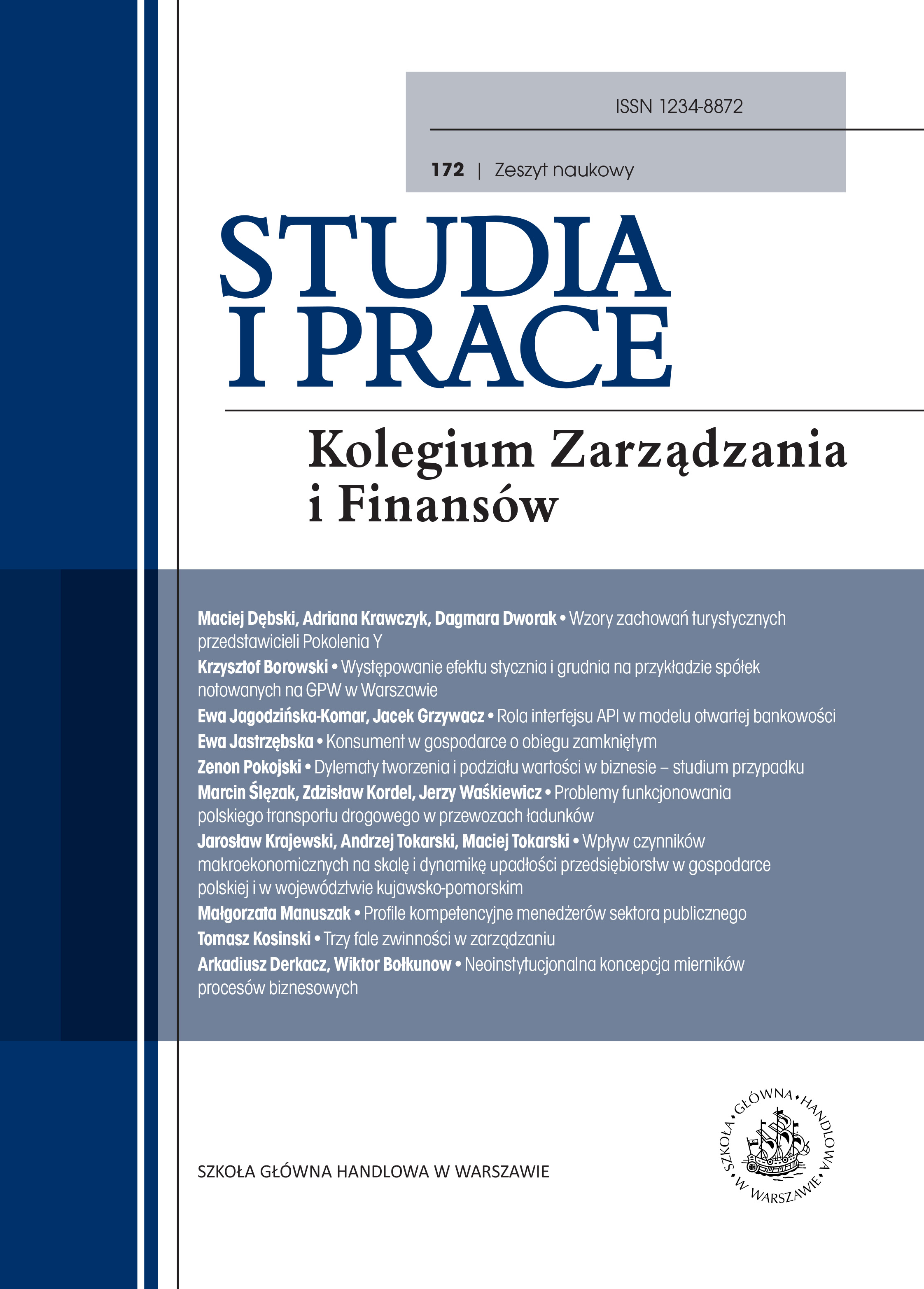Występowanie efektu stycznia i grudnia na przykładzie spółek notowanych na GPW w Warszawie
DOI:
https://doi.org/10.33119/SIP.2019.172.2Słowa kluczowe:
efektywność rynków finansowych, efekt grudnia, efekt stycznia, anomalie kalendarzoweAbstrakt
W artykule zamieszczona została analiza występowania efektu grudnia i stycznia w przypadku cen akcji spółek notowanych na GPW przy założeniu, że data pierwszego notowania akcji jest wcześniejsza niż 01.01.2000 r. Kryterium to spełniało łącznie 91 spółek. Do weryfikacji hipotez statystycznych wykorzystane zostały następujące statystyki: statystyki t, Manna-Whitneya (U test) oraz Kruskala-Wallace’a. Hipoteza zerowa została odrzucona częściej w przypadku spółek o małej i średniej kapitalizacji niż spółek o dużej kapitalizacji. W przypadku analizowanych spółek efekt stycznia był obserwowany częściej niż efekt grudnia, co jest zgodne z poglądami prezentowanymi w światowej literaturze. Artykuł wpisuje się w obszar prac poświęconych anomaliom kalendarzowym na rynkach finansowych, a zwłaszcza tzw. efektowi stycznia czy efektowi grudnia.
Downloads
Bibliografia
2. Asteriou D., Kavetsos G. [2006], Testing for the Existence of the January Effect in Transition Economies, „Applied Financial Economics Letters”, vol. 2, no. 6, s. 375–381.
3. Dimson E., Mussavian M. [1998], A Brief History of Market Efficiency, „European Financial Management”, vol. 4, no. 1, s. 91–193.
4. Easterday K., Sen P., Stephan J. [2008], The Persistence of the Small Firm/January Effect: Is it Consistent with Investors’ Learning and Arbitrage Efforts?, „Quarterly Review of Economics
and Finance”, vol. 49, no. 3, s. 1172–1193.
5. Fama E. [1970], Efficient Capital Markets: A Review of Theory and Empirical Work, „Journal of Finance”, vol. 25, no. 2, s. 383–417.
6. Fama E. [1991], Efficient Capital Markets II, „Journal of Finance”, vol. 46, no. 5, s. 1575–1617.
7. Grotowski M. [2008], Efekty kalendarzowe na Giełdzie Papierów Wartościowych w Warszawie, „Gospodarka Narodowa”, vol. 19, nr 1–2, s. 57–75.
8. Gu A., Simon J. [2003], Declining January Effect – Experience in the United Kingdom, „American Business Review”, vol. 21, no. 2, s. 117–121.
9. Haug M., Hirschey M. [2006], The January Effect, „Financial Analyst Journal”, vol. 65, no. 5, s. 78–88.
10. He L., He S. [2011], Has the November Effect Replaced the January Effect in Stock Markets?, Managerial and Decision Economics, vol. 32, no. 7, s. 481–486.
11. Hirsch J., Hirsch Y. [2001], Stock Market Almanac: Widely Yearly Updates, Wiley & Sons, Hoboken.
12. Keim D. [1983], Size Related Anomalies and Stock Returns Seasonality: Further Empirical Evidence, „Journal of Financial Economics”, vol. 12, no. 1, s. 3–32.
13. Keim D., Ziemba W. [2000], Security Market Imperfections in Worldwide Equity Markets, Cambridge University Press, Cambridge.
14. Lakonishok J., Smidt S. [1988], Are Seasonal Anomalies Real?, A Ninety-Year Perspective, „Review of Financial Studies”, vol. 1, no. 4, s. 403–425.
15. Lewandowska M. [2017], Efekt stycznia i grudnia na Giełdzie Papierów Wartościowych w Warszawie, „Journal of Capital Markets and Behavioral Finance”, vol. 1, no. 15, s. 17–28.
16. Malkiel B. [2003], The Efficient Market Hypothesis and Its Critics, „Journal of Economic Perspectives”, vol. 17, no. 1, s. 59–82.
17. Malkiel B. [2005], Reflections on the Efficient Market Hypothesis: 30 Years Later, „Financial Review”, vol. 40, no. 1 s. 1–9.
18. Osińska M. [2006], Ekonometria finansowa, PWE, Warszawa, s. 43–44.
19. Patel J. [2016], The January Effect Anomaly Reexamined In Stock Returns, „Journal of Applied Business Research”, vol. 32, no. 1, s. 317–324.
20. Patel J., Evans D. [2003], Seasonal Stock Return Patterns in the Seven Industrialized Nations, „International Business and Economic Research Journal”, vol. 19, no. 3, s. 111–120.
21. Purohit H., Tyagi P. [2015], Calendar Effect in Stock Markets of India and China: An Empirical Analysis of Month-of-the-Year-Effect, „Business Analyst”, vol. 36, no. 1, s. 69–81.
22. Rendon J., Ziemba W. [2007], Is the January Effect Still Alive in the Futures Markets?, „Finanzmarket and Portfolio Management”, vol. 21, no. 3, s. 381–396.
23. Rozeff M., Kinney W. [1976], Capital Market Seasonality: the Case of Stock Returns, „Journal of Financial Economics”, vol. 3, no. 4, s. 379–402.
24. Smalheiser N. [2017], How to Make Your Experiment Robust and Reproducible, Elsevier, New York.
25. Thaler R. [1992], The winner curse, The Free Press, New York.
26. Verheyden T., De Moor L., Bossche F. [2013], A Tale of Market Efficiency, „HUB Research Papers, Economics and Business Science”, vol. 5, no. 2, s. 45–46.
27. Weaver K., Morales V., Dunn S., Godde K., Weaver P. [2018], An Introduction to Statistical Analysis in Research: With Applications in the Biological and Life Sciences, Wiley & Sons,
Hoboken.
28. Witkowska D., Matuszewska A., Kompa K. [2006], Wprowadzenie do ekonometrii dynamicznej i finansowej, Wydawnictwo SGGW, Warszawa, s. 110–113.
29. Yavrumyan E. [2016], Efficient Market Hypothesis and Calendar Effects: Evidence form the Oslo Stock Exchange, Phd. Thesis, Department of Economics, University of Oslo.
30. Ziemba W. [1994], Investing in the Turn-of-the-Year Effect in the Futures Markets, „Interfaces”, vol. 24, 3, s. 46–61.









